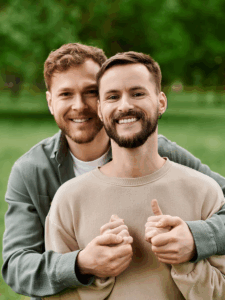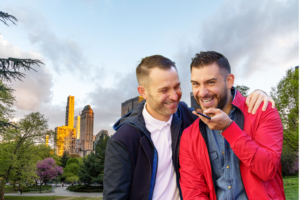Enhancing Connection: Effective Gay Couples Therapy
Are You Looking For Effectively Gay Couples Therapy? Considering couples therapy for gay couples? Understand the unique benefits and specialized approaches to help you and your partner confront relationship challenges and strengthen your bond. Our guide offers insights into navigating societal stigma, improving communication, and enhancing emotional intimacy within the LGBTQ+ context.
Key Takeaways
-
- Loneliness and internalized shame are prevalent issues among gay couples, and therapy can aid in fostering honest communication and self-acceptance, leading to stronger, healthier relationships.
-
- Effective couples therapy for gay partners focuses on overcoming communication barriers, developing shared goals, and addressing both internal and external stressors to reinforce mental well-being and relationship satisfaction.
-
- Couples therapy offers a safe and affirmative space for gay couples to cultivate empathy, resolve conflicts, and build resilience against social pressures like stigma and homophobia, enhancing their connection and community support.
Addressing Loneliness in Gay Relationships
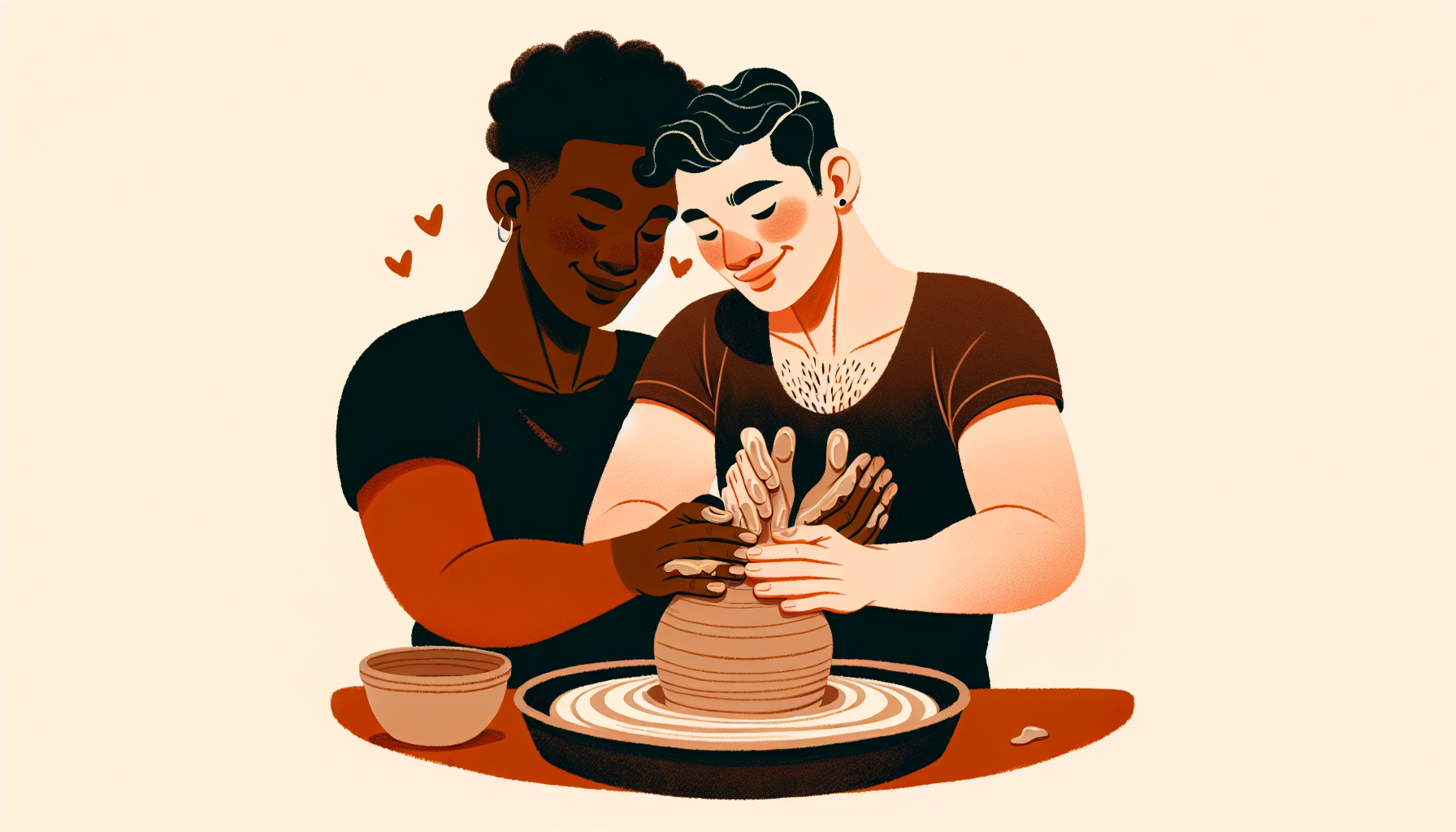
The silent echoes of loneliness often resonate in the hearts of gay men, reverberating through the intimate corridors of their relationships. It’s an unwelcome visitor, casting long shadows over the warmth of companionship, and its presence is felt more acutely within the LGBTQ+ community, as studies have shown higher levels of depression and less social support compared to their non-LGBTQ+ counterparts.
The insidious nature of loneliness, feeding on negative self-talk, can erode the foundations of a healthy relationship, leaving individuals feeling isolated within their partnership. However, couples therapy illuminates a path toward bridging emotional gaps and nurturing honest, intimate communication. Through such therapeutic work, the tender and vulnerable feelings beneath misunderstandings are revealed, allowing couples to rekindle intimacy and quell the pangs of isolation.
In a nurturing therapeutic environment, gay couples are empowered to face and break down the relationship challenges that induce loneliness. The journey toward a healthy relationship is not without its trials. Still, the barriers to connection can be overcome through the dedicated efforts of both partners and the guidance of a skilled therapist. This pathway leads to individual healing and fortifies the bonds of love, ensuring that the relationship becomes a sanctuary for both partners.
Societal Stigma and Internalized Shame
Society’s harsh glare often casts long shadows over the lives of gay men, where the tendrils of stigma and shame twist their way into the sanctuary of love, corrupting it with doubts and fears. The weight of internalized shame, fostered by a world not always kind, increases the risk of mental health problems and can lead to a sexless partnership, devoid of the vulnerability and connection that define a healthy relationship. However, the effectiveness of couples therapy is reflected in its capacity to guide partners through these challenging times, providing relief from social pressures and biases. By addressing shame and attachment style, therapy affirms their identities, legitimizes their relationships, and provides a bulwark against the toxic effects of societal opinions and external pressures.
Loneliness, a significant issue within LGBTQ+ relationships, often finds fertile ground in the stigma and the resultant feelings of being misunderstood or invalidated, but therapy can help mitigate this, fostering a sense of belonging and understanding.
The journey toward self-acceptance and shared acceptance within a relationship is a delicate dance that requires patience, perseverance, and the courage to be vulnerable. As couples work through the layers of societal stigma and internalized shame, they discover new depths of connection and resilience. This therapeutic process is not merely about navigating external pressures; it’s a profound exploration of the self and of the relationship that can transform the very fabric of their lives.
Communication Barriers
Effective communication, frequently overlooked, accounts for a significant portion of relationship hurdles that gay couples face. The barriers to effective communication can feel insurmountable, whether it’s the struggle to articulate deep-seated emotions or the fear of misunderstanding. However, under the guidance of LGBTQ+ couples counseling, couples can achieve new depths of understanding, establishing a connection that is both deep and liberating.
In the complexities of modern relationships, such as navigating the parameters of open relationships, the role of enhanced communication cannot be understated. Gay Couples Therapy identifies effective communication as a keystone in restoring the vitality of stressful relationships, underscoring its importance in pursuing a healthy relationship. Loneliness can twist the threads of dialogue, turning even the simplest conversations into mazes of misinterpretation, but through therapy, the communication barriers that exacerbate mental health issues can be dismantled.
When partners unite, their harmonious voices may orchestrate a symphony of understanding or a discordant cacophony. Learning to navigate the nuances of communication, to listen with empathy, and to speak with clarity is a journey that couples undertake in therapy. It is a journey that strengthens the bonds of their relationship and allows them to face the world as a united front, fortified by the power of their shared voice.
Building a Supportive Social Network
A supportive social network frequently forms a crucial part of the fabric of a healthy relationship. In the context of gay relationships, where loneliness can cast long shadows, the particular significance of such a network cannot be overstated. Building strong relationships with friends, family, and peers engenders a sense of belonging, a bastion against the tides of isolation. Peer acceptance and the comfort of close relationships are pillars upon which personal relationships can thrive, offering respite and joy in times of need.
Cultivating a supportive social network is both a personal and a collective endeavor. It is a journey that requires openness, trust, and the willingness to extend beyond the familiar. As gay couples weave these connections into the fabric of their lives, they find strength in numbers, comfort in solidarity, and joy in shared experiences. The bonds they form become lifelines, ensuring they are never alone even in the darkest times.
Fostering Mental Well-Being in Gay Couples Therapy
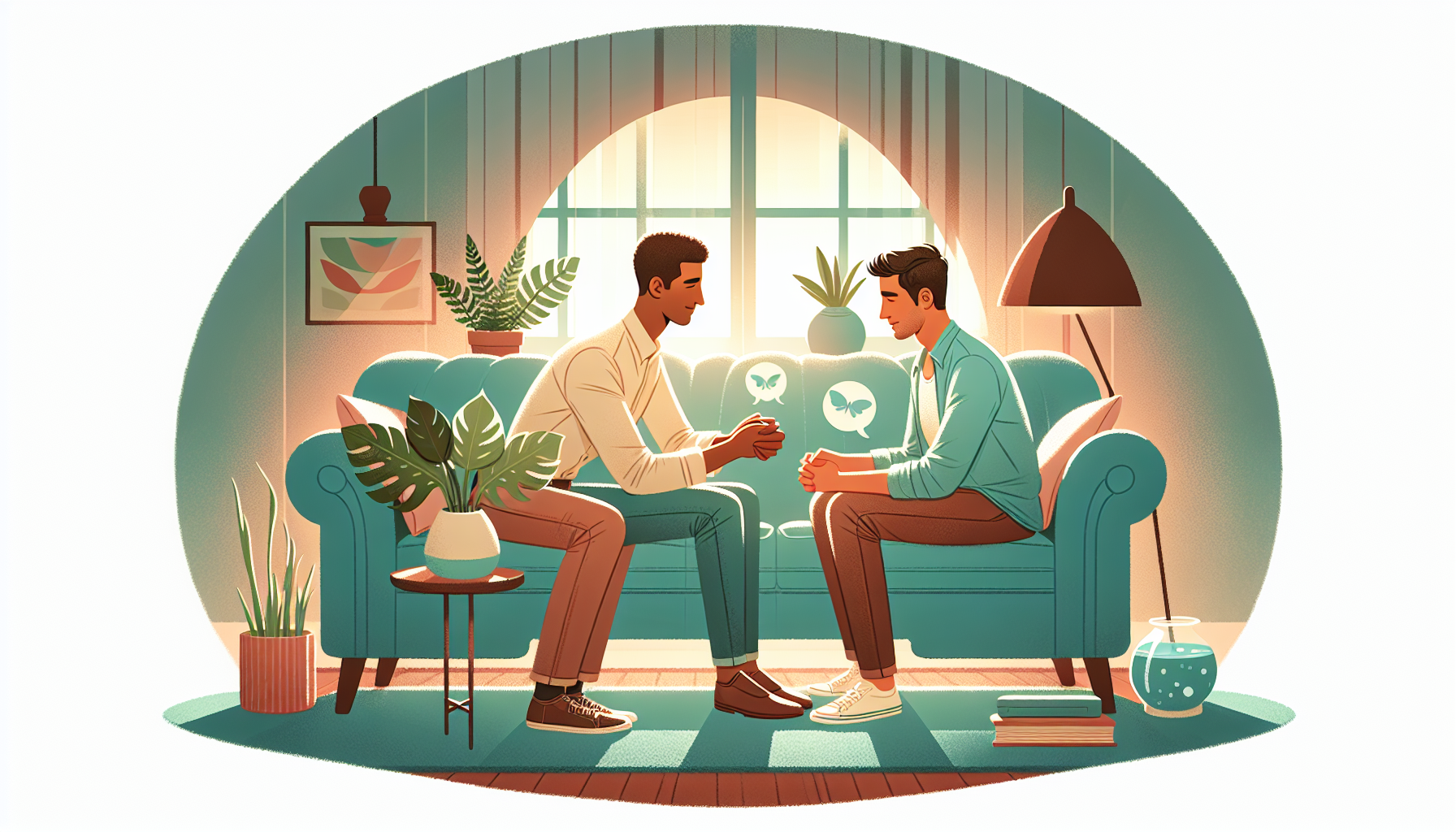
Amidst the dynamic and oftentimes difficult terrain of gay relationships, mental health serves as a guiding light through the haze of uncertainty. Despite strides in legal and social acceptance, the specter of depression looms large, with loneliness stubbornly persisting in the gay community. The sanctity of the therapeutic space becomes a haven, a place where complex issues can be unpacked and the soothing balm of belonging and acceptance can be applied. Self-compassion, a cornerstone of therapy, equips individuals with the emotional intelligence and resilience to navigate the storms that may arise within their relationships. The recent global crisis of the COVID-19 pandemic has only accentuated the crucial role of cognitive restructuring strategies, such as combating negative self-talk, in maintaining mental health and fortifying the emotional connection between partners.
As couples embark on the therapeutic journey, they unlock the potential for profound transformation. This evolution alters the dynamics of their relationship and catalyzes a ripple effect of well-being that extends into every corner of their lives. Within the sanctuary of therapy, partners learn to navigate the complexities of their inner worlds, transforming challenges into opportunities for growth and connection.
Emotion-Focused and Schema Therapy
The vibrant streets of New York City, epitomizing urban life, frequently mirror the inner battles of gay men dealing with negative patterns tied to past hurts. Schema therapy offers a map to navigate this terrain, guiding individuals through identifying and transforming these ingrained patterns. Through techniques like role-playing and visualization, participants in group schema therapy can gain insight into their schemas, reshaping their thoughts, emotions, and behaviors in a supportive setting. Cognitive restructuring and exposure therapy are additional tools within schema therapy that confront and challenge negative beliefs and fears, allowing individuals to face these inner demons with courage and support.
Emotionally Focused Therapy (EFT) complements schema therapy by honing in on the heart of emotional connection within couples. It empowers partners to alter negative patterns of interaction, fostering stronger bonds through active listening and reflection. The magic of EFT lies in its ability to transform emotional turmoil into a deepened understanding and empathy, essential ingredients for a thriving relationship.
Developing Shared Goals and Activities
Shared goals and activities, like threads in a tapestry, enrich a relationship by uniting partners in a collective journey toward fulfillment. Couples therapy becomes a workshop where these aspirations are crafted and refined, aligning individual dreams into a cohesive vision. This alignment is a bulwark against conflict and a pathway to deeper emotional intimacy.
Collaborating on projects, whether launching a business, nurturing a family, or engaging in community service, infuses the relationship with a sense of purpose. A significant relationship goal might manifest in joint adventures, equitable sharing of domestic tasks, or saving for future dreams. Those in a healthy relationship reported higher satisfaction levels when working together towards common goals.
As couples weave these shared aspirations into their narrative, they discover a renewed sense of partnership. Their activities become more than just tasks; they express their love and commitment to their future and celebrate their unity. Through therapy, these endeavors are envisioned and brought to life, fostering a bond that is as enduring as it is dynamic.
Addressing External Stressors
The external world beyond the confines of a relationship is rife with stressors challenging the resilience of gay couples. Prejudices like homophobia and societal stigma can manifest as work-related stress and financial difficulties, adding strain to the lives of gay individuals. These external pressures can lead to tangible consequences such as reduced income, job insecurity, and limited access to quality health care, all of which can fuel feelings of loneliness and erode the bedrock of a relationship. The impact of minority stress is palpable among gay men, with heightened levels of anxiety and depression serving as stark reminders of the challenges they face, including an increased risk of mental health issues. Couples therapy serves as a crucible for developing strategies to confront and manage these external stressors, enhancing the overall mental well-being of gay couples.
The journey through therapy is one of navigation and negotiation as couples learn to steer their relationship through the tumultuous waters of external challenges. By recognizing and addressing these stressors, therapy empowers couples to survive and thrive amidst adversity. Through this process, partners can fortify their bond, ensuring that no external force can diminish the love and support they share.
Creating a Safe and Affirming Space in Therapy
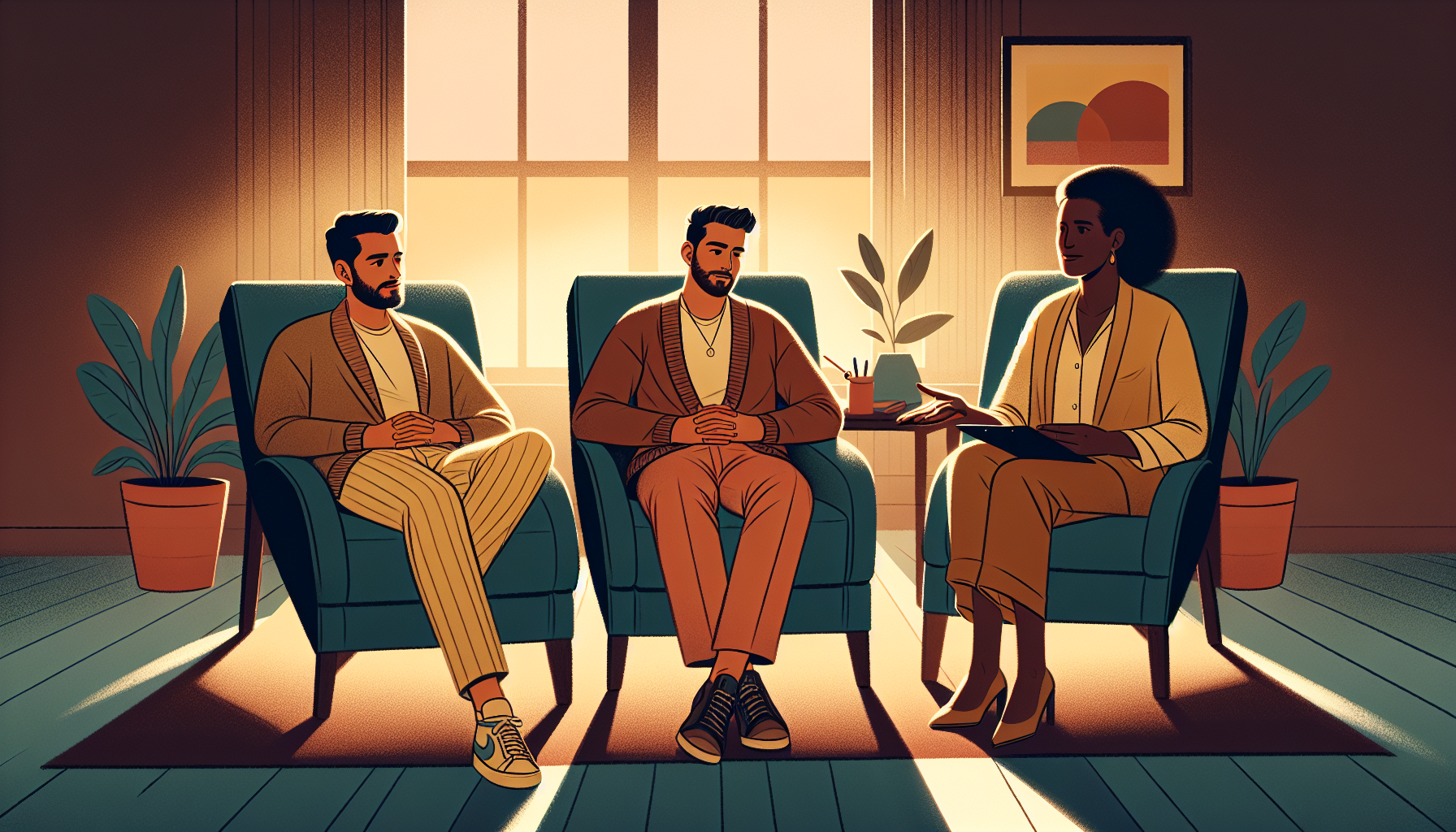
The therapeutic sanctuary is rooted in establishing a secure and affirming environment where individuals can openly express themselves without fearing judgment or discrimination. It is a place where microaggressions are actively avoided, clients feel respected and validated, and empowerment is not just a concept but a lived experience. Inclusive language and a keen understanding of LGBTQ+ specific issues, like systemic injustices, become the tools with which therapists build a culture of understanding and acceptance. This culture extends beyond the therapy room, fostering an environment where clients learn to advocate for themselves and embrace their identities with pride.
The practice of empathy within therapy is an art form requiring therapists to:
-
- Honor the spectrum of sexuality and gender
-
- Respect clients’ language preferences around their identities
-
- Engage in active listening to create a secure space where emotional bonds can be nurtured and strengthened
By addressing the unique conflicts and emotional needs of gay couples, therapists guide their clients toward a deeper connection, one that can withstand the pressures of a world that often fails to understand them.
Cultivating Empathy and Active Listening
Authentic listening extends beyond merely hearing words; it involves fully engaging with another person, maintaining eye contact, and employing verbal and non-verbal cues to indicate genuine interest and understanding.
Here are some strategies to practice authentic listening:
-
- Maintain eye contact with the speaker
-
- Use open-ended questions to encourage deeper conversations
-
- Avoid judgment and create a safe space for the speaker to share
-
- Validate the speaker’s emotions with empathy statements
-
- Make an effort to understand multiple perspectives, especially in conflicts
By practicing these strategies, you can foster an environment where empathy can flourish, and mutual understanding can be achieved. Amid conflicts, such empathetic language and the effort to understand multiple perspectives can de-escalate tensions and pave the way to resolution.
As therapists guide couples in cultivating empathy and active listening, they unlock a powerful tool for connection. This tool allows partners to truly see each other, understand the nuances of their experiences, and navigate their relationships with grace and understanding. The journey through therapy becomes a journey of discovery, where the language of empathy becomes the dialect of love.
Resolving Conflicts and Unmet Emotional Needs
The path of a relationship is rarely without its obstacles, and for gay and bisexual youth, rejection from their families can lead to severe mental health issues that bleed into their adult relationships. Therapy becomes a space where these personal issues, including family acceptance and role expectations, can be explored and resolved, leading to improved communication and understanding between partners. Couples therapy also offers solutions to the unique challenges faced by LGBTQ+ couples, such as family planning and relationship transitions, providing the tools necessary to overcome these hurdles. By establishing shared goals and support mechanisms, therapy helps LGBTQ+ couples to meet their emotional needs and reduce feelings of loneliness, ensuring that their relationship is a source of strength and comfort.
As therapists work with couples to resolve conflicts and address unmet emotional needs, they lay the groundwork for a relationship that is not just sustainable but flourishing. This resolution and reconciliation process is not merely about finding common ground but creating new ground upon which both partners can stand together, united in their love and commitment.
The Impact of Social Media on LGBTQ+ Relationships
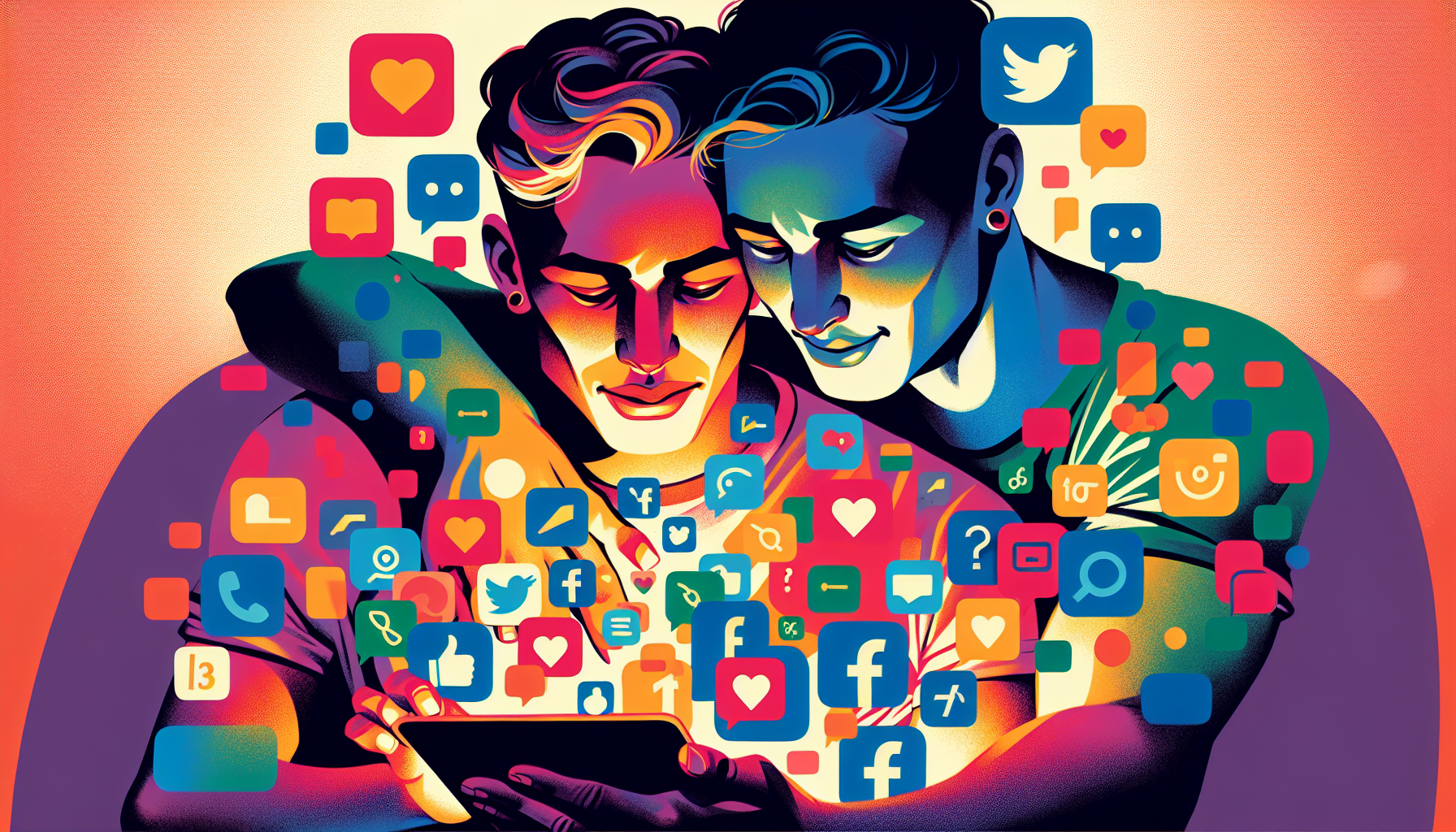
In the digital age, social media platforms have become the town squares and coffee shops for LGBTQ+ individuals, including bisexual adults, a place where socializing, identity expression, and seeking emotional support coalesce. While these platforms offer a sense of community connectedness and can serve as a buffer against internalized stigma, they are not without their pitfalls. As gay men and lesbian individuals engage online, high emotional investment can paradoxically correlate with increased feelings of loneliness and isolation. This concern can be addressed through the reflective process of couples therapy. The double-edged sword of social media, with its ability to connect and isolate, underscores the importance of understanding its impact on personal relationships within the LGBTQ+ community.
Navigating the complex social media web is a modern-day challenge requiring individual and collective awareness. It is essential for couples to understand the influence these platforms can have on their relationship and find ways to use them to their advantage. Through therapy, couples can learn to harness the positive aspects of social media while minimizing its potential to exacerbate feelings of loneliness and disconnection.
Hookup Culture and Body Image
The insidious pressures of hookup culture, with its emphasis on physical attractiveness and sexual gratification, cast a long shadow over the self-esteem of many individuals, regardless of their sexual orientation. In a recent study, gay men reported that the pursuit of an ideal body type, often glorified within these environments, can lead to a relentless cycle of comparison and dissatisfaction. This fixation on conforming to masculine standards prevalent in the gay community not only creates health concerns but also contributes to the stress and loneliness experienced by its members. As these elements of hookup culture converge, they collectively exacerbate feelings of loneliness and alienation, both mentally and physically, potentially leading some individuals to alcohol abuse.
The journey to self-acceptance and a healthy body image can be fraught with challenges, but it is crucial to fostering a strong and resilient sense of self. In therapy, individuals with low self-esteem can explore the impact of these societal pressures on their relationships and work towards a more compassionate and accepting view of themselves. By addressing these issues within the context of their partnership, couples can support each other in breaking free from the harmful narratives perpetuated by hookup culture and build a relationship founded on mutual respect and genuine attraction.
Navigating Social Media Together
The digital landscape of social media presents a new frontier for gay couples to navigate together. Defining boundaries within these platforms is crucial, as it helps prevent misunderstandings and feelings of exclusion that can arise between partners. Moreover, the portrayal of relationships and personal appearances on social media can create unrealistic expectations, leading to dissatisfaction and loneliness within the relationship.
However, when couples engage in positive online activities, such as sharing their relationship story or supporting important causes, they can strengthen their connection and reinforce their identity as a couple. By following accounts that promote positive LGBTQ+ content, couples can also bolster their sense of community, belonging, and relationship validation.
The shared experience of navigating social media can be both a bonding activity and a learning curve for couples. It is an opportunity to:
-
- Set a united front
-
- Decide what aspects of their relationship to share and to keep private
-
- Support each other through the highs and lows of online interactions.
Through therapy, couples can develop strategies to manage their social media use to enhance their relationship rather than detract from it, turning what could be a source of tension into an avenue for growth and connection.
Self-Compassion and Positive Self-Talk in Gay Couples Therapy
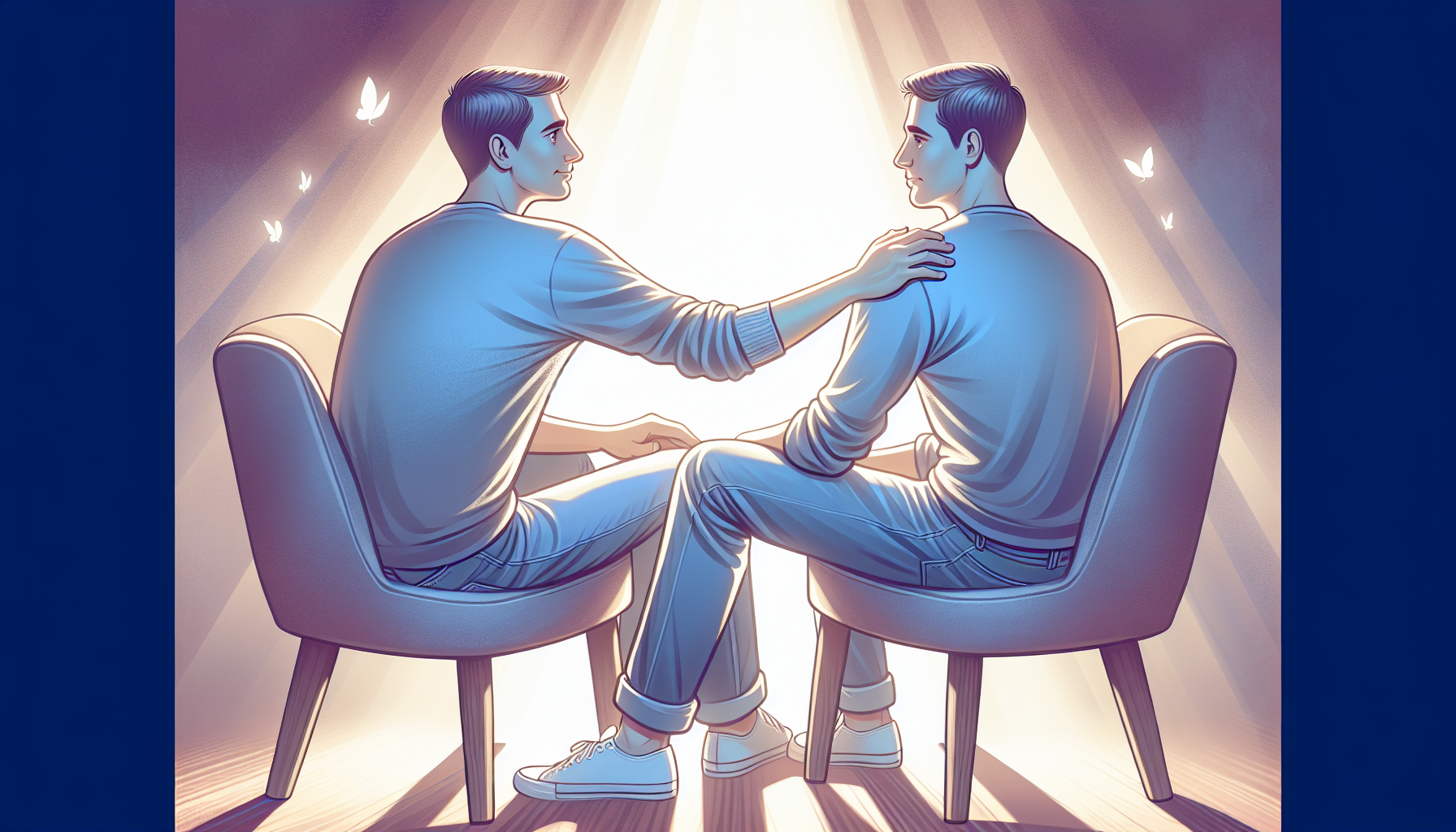
The embrace of self-compassion within therapy is akin to offering oneself a sanctuary of understanding and kindness that we would extend to a good friend in distress. This nurturing approach to self-care is paramount when navigating life’s challenges, creating a supportive internal environment that fosters resilience and well-being. The dual aspects of tender and fierce self-compassion enable individuals to comfort themselves while taking proactive steps to alleviate their suffering. True self-compassion is not about self-pity or indulgence; it’s about recognizing and sharing in the human experience, striving for long-term well-being rather than temporary solace. Gay men, in particular, facing intense societal pressure to conform to certain body image ideals, can find relief and empowerment through self-compassion, as it can lead to a healthier self-view and mitigate potential mental health issues.
Studies underscore the benefits of self-compassion, with individuals who practice it reporting better mental and physical health outcomes. The Mindful Self-Compassion program, for instance, teaches techniques to counteract self-criticism and manage difficult emotions more effectively.
In couples therapy, fostering self-compassion can improve relationship satisfaction by encouraging partners to treat themselves and each other with greater understanding and kindness.
Challenging Negative Thoughts
The battle against negative thoughts and self-criticism is a central theme in the narrative of gay relationships, where internalized homonegativity can cast a shadow over one’s self-worth. Recognizing when self-critical talk arises and consciously working to interrupt this pattern is the first step towards cultivating a healthier self-perception. Techniques such as:
-
- Saying negative thoughts aloud to highlight their unreasonableness
-
- Employing affect labeling to reduce emotional intensity
-
- Giving a nickname to your inner critic to diminish its power
can all serve as effective strategies in this endeavor. By limiting the time spent engaging with the inner critic and replacing negative thoughts with the kindness one would offer a friend, individuals can mitigate the effects of self-critical talk and foster a sense of self-compassion that radiates into their relationships.
Overcoming the insidious nature of negative self-talk is a journey that often requires guidance and support. In therapy, individuals learn to challenge and reframe their thoughts, transforming the inner landscape from one of criticism to one of support. This shift benefits the individual and strengthens the relationship, as partners who view themselves positively are better equipped to engage in healthy, loving interactions.
Developing a Positive Mindset
Nurturing a positive mindset is akin to planting a garden of optimism within one’s mind, where gratitude, hope, and resilience can flourish. Regularly practicing gratitude, for instance, can shift focus away from perceived deficiencies and towards the abundance present in one’s life and relationship, fostering happiness and well-being. Identifying automatic negative thoughts and actively reframing them helps create an internal dialogue that supports not only individual mental health but also the health of the relationship. Challenging long-held beliefs about oneself and the world can break the cycle of negativity, paving the way for a more optimistic and fulfilling approach to life and relationships. Indeed, findings suggest that an optimistic outlook within a relationship is linked to greater satisfaction and resilience in the face of challenges.
As individuals embrace a positive mindset, their perspective on life and their relationship transforms. They become more resilient, appreciative of their partner, and capable of weathering the storms that may come their way. In therapy, couples cultivate this mindset together, reinforcing their bond and building a shared vision of a hopeful future.
Next steps: book an appointment
Choosing to undertake the journey of gay couples therapy signifies a significant move towards strengthening bonds and tackling the unique challenges that LGBTQ+ individuals encounter in their relationships. An initial phone consultation, often offered free of charge, can match couples with a suitable LGBTQ+ therapist who can navigate communication issues and other challenges that may arise. These counseling sessions are designed to be results-oriented, equipping couples with new communication skills and strategies to foster a stronger, more resilient relationship. Compatibility with the counselor is key, ensuring a therapeutic environment conducive to intimacy, vulnerability, and improved communication. Individuals are encouraged to schedule a consultation to begin this transformative journey, taking the first step towards a healthier, more fulfilling partnership.
In therapy, couples explore new aspects of their relationship, master effective communication techniques, and learn how to provide mutual support through life’s challenges. This process strengthens their bond and empowers them as individuals, ready to face the world with confidence and love.
Summary
In traversing the landscape of gay relationships, we’ve uncovered the multifaceted nature of loneliness, the importance of communication, and the transformative power of couples therapy. We’ve explored the complexities of societal stigma, the impact of social media, and the nurturing force of self-compassion. Through the lens of empathy and active listening, the resolution of conflicts, and the fostering of a positive mindset, therapy offers a path to a deeper, more resilient connection. It is a journey of self-discovery, partnership, and growth, leading to relationships that are not only enduring but also filled with understanding, support, and love.
Frequently Asked Questions
What kind of therapy is best for couples?
Cognitive Behavioral Therapy (CBT) effectively treats communication difficulties and conflict resolution, making it a good option for couples therapy.
How does couples therapy specifically address the needs of gay couples?
Couples therapy for gay couples addresses their unique challenges, such as societal stigma and communication barriers, providing a safe space to explore vulnerabilities and develop strategies for a healthier relationship.
Can therapy help if one partner is struggling with internalized homophobia or shame?
Yes, therapy can be very helpful in addressing internalized homophobia or shame within a relationship. It provides a supportive space to work through these feelings and fosters self-acceptance and a stronger bond between partners.
What role does social media play in gay relationships, according to therapy?
Therapy can help gay couples navigate social media to strengthen their relationship, as it can offer a sense of community and support but can also lead to feelings of loneliness and unrealistic expectations.
How does self-compassion improve relationship satisfaction in gay couples therapy?
Self-compassion improves relationship satisfaction in gay couples therapy by promoting kindness and understanding toward oneself. This results in better communication and enhanced interactions with a partner, ultimately leading to greater relationship satisfaction.















